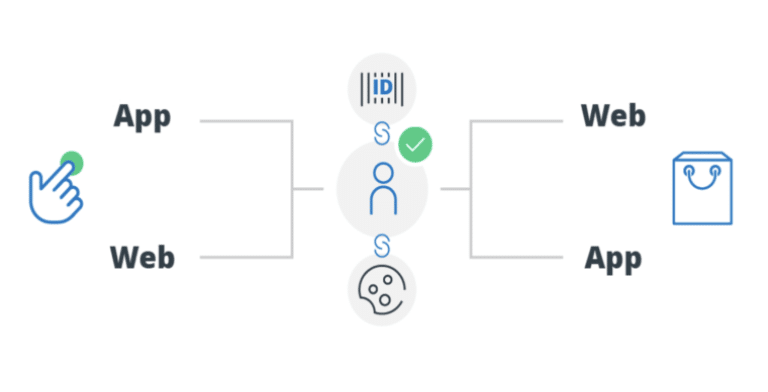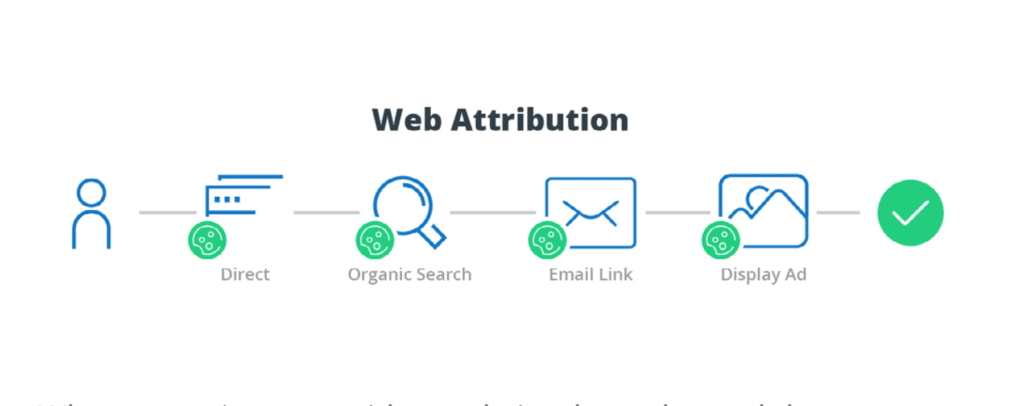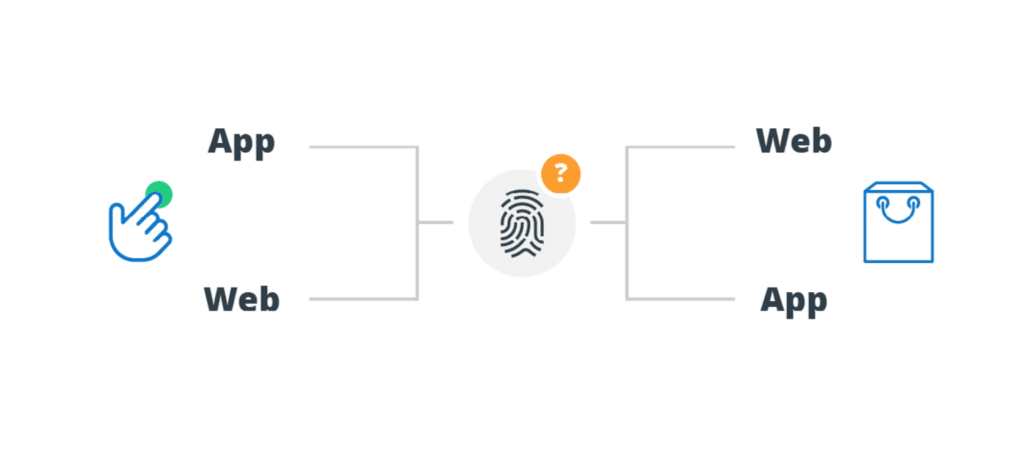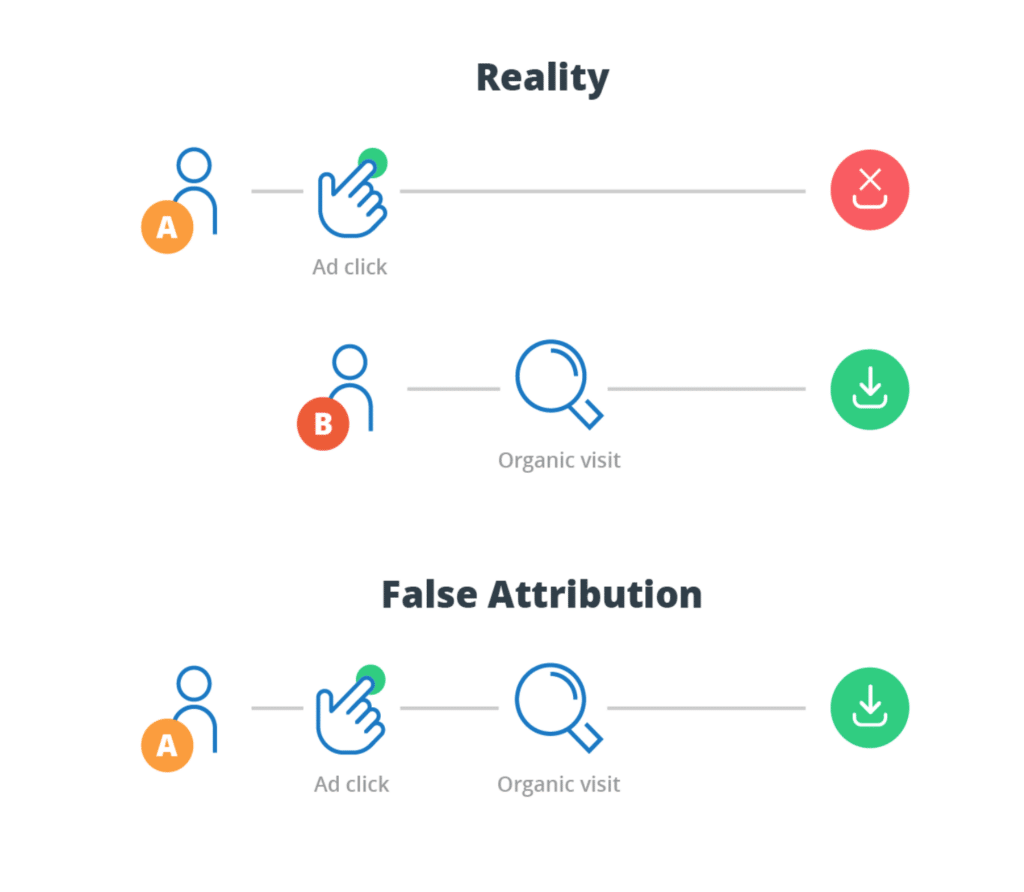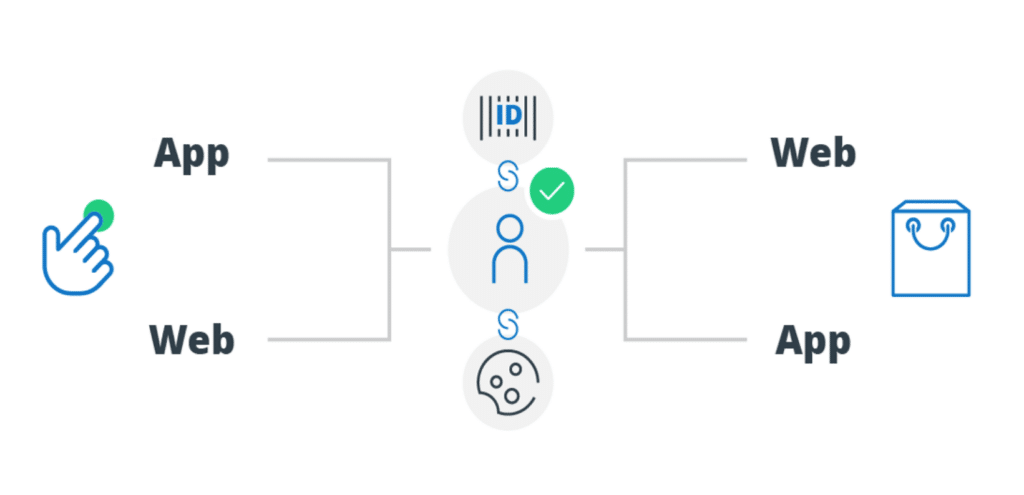As mobile app install attribution on iOS and Android (and the user journeys it aims to track) continue to evolve, app attribution has become an increasingly important aspect of growth leaders’ strategies. Mobile app attribution can seem like a complicated, complex tangle of channels, platforms, and devices—especially once broken down into organic mobile app installs and paid mobile app installs—but it doesn’t have to be.
In this guide, we’ll break down how to achieve optimal mobile app install attribution on iOS and Android, so you can be sure you’re relying on mobile app install attribution that works.
First, however, let’s take a quick look at why cookie-based mobile app attribution fails marketers and product professionals who attempt to track app install attribution with it.
The Fallacy of Cookie-Based App Install Attribution
It first makes sense to quickly review the objectives and execution behind standard web-based attribution models. Web attribution is made scalable (and therefore achievable) by tools that capture user behaviors and tie them back to a given user’s browser cookie.
Cookies are used as unique user identifiers in web attribution. Cookie-based web attribution allows marketers to track traffic sources to their websites, conversion rates by source, and other measures of user activity.
Tracking web traffic sources is generally achieved through the use of UTM parameters, such as example.com/product?source=facebook&medium=cpc. Attribution providers can also use network-based attribution methods to look at cross-domain cookies to help determine a user’s source.
Most of the time, the objectives of web-based attribution are less along the lines of app install attribution, and more along the lines of determining web user origin and tracking all subsequent web actions. This is primarily because, unlike the worldwide web, mobile apps are inherently siloed and, therefore, don’t have access to browser cookies.
Since users are identified in apps in a completely different manner (via IDFAs for iOS and GAIDs for Android), it is not possible to recognize the same user across both web and app platforms using a cookie-based model of attribution. (Not to mention the fact that users can disable browser cookies upon request, cookies expire, and some browsers set cookie restrictions and limits.)
Do Pixel Tags Work?
Marketers and product professionals also use pixel tags, invisible bits of webpage code that log user activity, to attribute web-based user acquisition and behavior. When a user visits a page with a pixel tag, the web browser will download the pixel image. Pixel tags can be useful in attribution on the web because they measure results when placed on conversion confirmation pages.
Pixel tags, just like cookies, are only reliable on the web, and therefore are not useful when approaching mobile app attribution on iOS or Android. For this reason, effectively measuring mobile app install attribution with cookies or pixel tags is simply not possible, and never will be.
Android Mobile App Install Attribution
To provide app install attribution for Android apps, Android relies on embedding referral URL parameters into Google Play Store download links. The Google Analytics Android SDK populates campaign attribution data in Google Analytics for your app, which enables you to track subsequent down-funnel conversion events (or other user behaviors) and to attribute back to a given app install source.
There are a few substantial weaknesses at play when it comes to this approach, however. For one thing, by importing your data into Google Analytics via Google Install Referrer, you can’t send app install attribution data to advertising partners and publishers, which can complicate (or even prevent) optimizing or A/B testing ads from the ad partner side.
Perhaps even more worrisome is the simple fact that using Google Install Referrer limits visibility into user journeys to only their last pre-install touch. In this way, you’re effectively treating your users like a sequence of segmented sessions and clicks, which hinders visibility into more actionable insights about the full scope of the journeys your users are making to download your app. More on that later, though.
iOS Mobile App Install Attribution
Perhaps you’re looking to buy app installs on iOS, perhaps you’re looking for the best iOS app install tracker out there, or perhaps you’re an iOS app install ad veteran simply looking to optimize install ads. Wherever you are on this spectrum, it’s important to understand that even in iOS 11 (on the dawn of iOS 12), iOS app install attribution is not improving as Apple continues to develop its beloved App Store.
To the contrary, as Apple continues to ignore app install tracking, user acquisition journeys are becoming more complex, spanning multiple channels, platforms, and even devices. Even in the simplest scenario, however (conventional attribution breaks at the point of app install. When it comes to iOS mobile app install attribution in this day and age, the necessity of a cross-channel, cross-platform attribution tool is only increasing.
App Install Attribution & Device Fingerprinting
You’re probably wondering whether you can use a legacy attribution technique like basic probabilistic modeling in order to track user journeys that cross channels and platforms. Although basic probabilistic modeling has become the most common cross-platform attribution tactic for app install ads tracking, this method unfortunately doesn’t measure app install attribution reliably.
Let’s first take a look at basic probabilistic modeling as it relates to tracking mobile app install ads and campaigns today. This method generates a snapshot of a web user, consisting of a device’s IP address and user agent (the device operating system, the OS version, and other device-specific parameters), and generates another snapshot when this user opens the app. The attribution provider then attempts to find close matches among the collected web fingerprints and app fingerprints.
Basic probabilistic modeling results in varying degrees of accuracy, but can never be 100% accurate. At best, it will always be a guessing game, because of the tools on which device fingerprinting relates—namely, the user agent and the user’s IP address. (Curious what user agents and IP addresses are, and how they poke holes in the accuracy of device fingerprinting? Check out our Ultimate Guide to Web and App User Attribution for the answers!)
The Consequences of Basic Probabilistic Modeling
The limitations of basic probabilistic modeling mean that if two users use the same public wifi or are in close proximity on the same network in a 24-hour period, and they happen to have the same device model and operating system version, a model using this method will label these users as identical, causing inaccurate attribution (also known as “False Attribution”).
To reduce inaccuracy while mitigating false attribution, attribution providers set time windows for when a match can be made. These time windows are usually less than 24 hours, meaning that if a user clicks a web display ad and installs the app over a day later, the user’s web activity and source will not be matched to the user’s app activity.
Ironically, setting attribution time windows introduces additional inaccuracy for the exact opposite reason. That is, attribution providers will misattribute users as organic installs simply because they converted outside of the 24 hour attribution window. This could easily mask gaps in acquisition strategy, as well as channels that seem to be underperforming but in reality are driving revenue.
The Solution: Branch’s Attribution Model
Branch’s attribution Engine enables companies across industries and stages of growth to perform reliable cross-platform attribution without fragmentation-induced misattribution. Rather than using basic probabilistic modeling, Branch has built an link graph that measures a device’s web cookies to its unique app identifier as one user across web and app platforms.
The Branch link graph contains browser cookie to IDFA/GAID relationships for all users that interact with apps within the Branch network. With more than 30,000 apps actively within the Branch network on a monthly basis, Branch’s link graph has reached an extremely reliable scale.
To achieve accurate cross-platform attribution using Branch’s vast identity graph, Branch will use an app user’s device ID to search for a matching browser cookie. This browser cookie can then be used to connect that user’s past web activity with their app activity (or vice versa). Since the browser cookie and device ID are completely unique, Branch can guarantee a match between the web visitor and app visitor, unlike attribution providers that rely on fingerprinting. With this guaranteed deterministic matching, Branch is also able to look beyond the conventional 24-hour matching window that limits fingerprinting methods.
Unlike legacy attribution providers who rely on basic probabilistic methods, Branch is able to connect users no matter their activation, engagement, or conversion speed, regardless of first-touch-to-conversion window.
Ultimately, Branch’s attribution stitches a user’s journey together, offering marketers and advertisers a single, de-duplicated persona that represents a real human consumer, rather than an unreliable fingerprint, pixel, or cookie.
With the ability to map out real consumer journeys across web and app, marketers can finally access an integrated and comprehensive view across all marketing campaigns. Marketers and advertisers plugged into Branch’s attribution can allocate digital marketing and mobile budgets based on the performance of previous and current web and app campaigns. As such, they can maximize ROI and scale campaigns with confidence.
Curious how Branch can help you ditch basic probabilistic modeling for cross-platform attribution that gives you visibility into the full user journey? Click here to request a demo, and click here to learn more about Branch’s robust attribution engine!






















